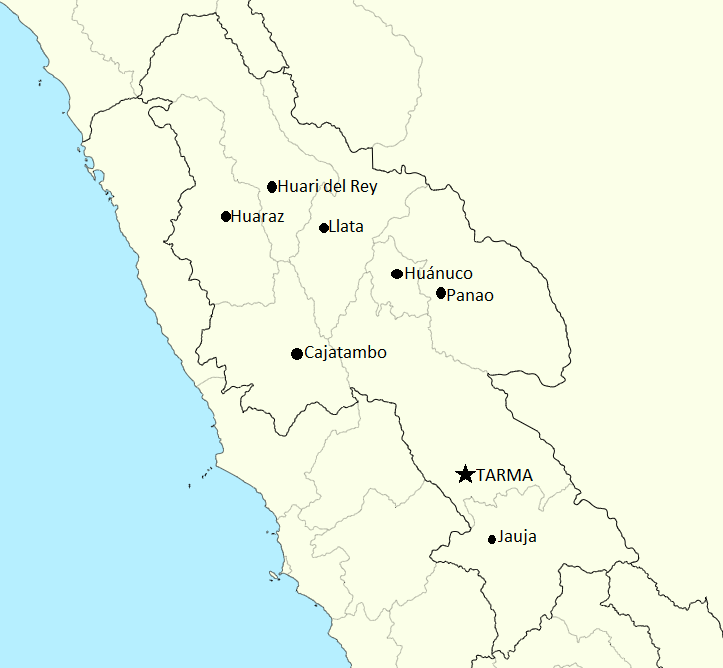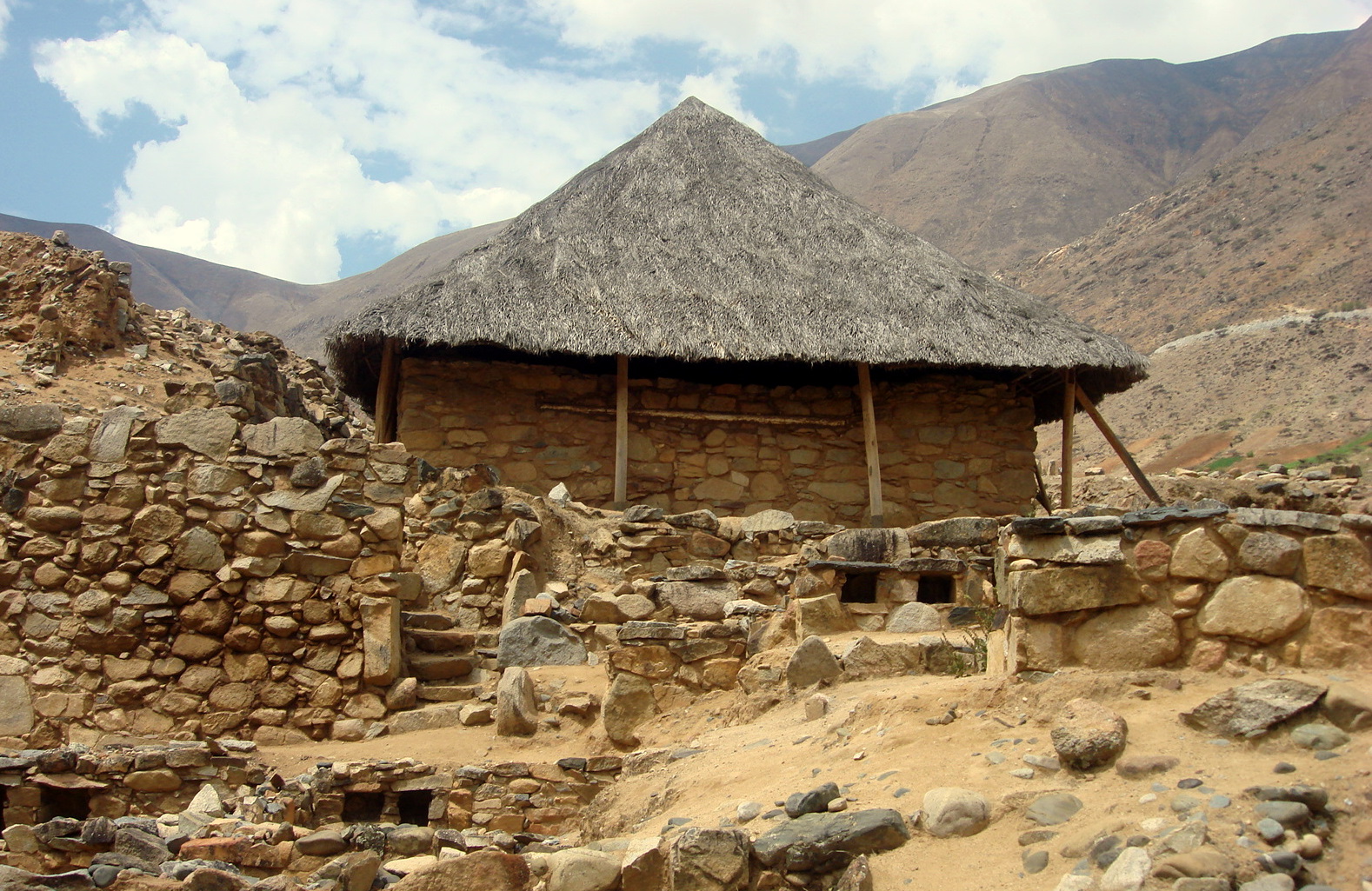|
Intendancy Of Tarma
The Intendancy of Tarma (), also known informally as Tarma Province (), was one of the territorial divisions of the Viceroyalty of Peru. The territory was ruled from Tarma. It existed from its creation in 1784 until it was Reglamento Provisional, replaced by the Regions of Peru, departments of Department of Tarma, Tarma and Department of Huaylas, Huaylas on February 12, 1821. History The corregimientos were suppressed in 1784 by King Charles III of Spain, Charles III and replaced by the Intendencia indiana, intendancies. The intendancy system was established in the Viceroyalty of Peru by royal order of August 5, 1783, and the Royal Ordinance of Intendants of January 28, 1782 was applied. In the territory of the Archdiocese of Lima, archbishopric of Lima, the intendancies of Intendancy of Lima, Lima and Tarma were created. The intendancy of Tarma was made up of the ''corregimientos'' of Tarma, Huaylas, Jauja, Cajatambo, Conchucos, Huamalíes and Huánuco. The first intendant of Tar ... [...More Info...] [...Related Items...] OR: [Wikipedia] [Google] [Baidu] |
Intendencia Indiana
An intendant (; pt, intendente ; es, intendente ) was, and sometimes still is, a public official, especially in France, Spain, Portugal, and Latin America. The intendancy system was a centralizing administrative system developed in France. In the War of the Spanish Succession of 1701 to 1714 the French royal House of Bourbon secured its hold on the throne of Spain; it extended a French-style intendancy system to Spain and Portugal - and subsequently worldwide through the Spanish Empire and Portuguese Empire. Regions were divided into districts, each administered by an intendant. The title continues in use in Spain and in parts of Spanish America for particular government officials. Development of the system in France Intendants were royal civil servants in France under the Old Regime. A product of the centralization policies of the French crown, intendants were appointed "commissions," and not purchasable hereditary "offices," which thus prevented the abuse of sales ... [...More Info...] [...Related Items...] OR: [Wikipedia] [Google] [Baidu] |
Royal Army Of Peru
The Royal Army of Peru ( es, Ejército Real del Perú), also known as the National Army ( es, Ejército Nacional), was the army organised by the viceroy of Peru, José Fernando de Abascal, to protect the Hispanic Monarchy in the Viceroyalty of Peru—and its surrounding provinces of Charcas, Chile and Quito—of the revolutions that convulsed the Spanish Empire at the beginning of the 19th century. This army was made up of 80% Creoles and indigenous Peruvians. See also *Peruvian War of Independence *United Liberating Army of Peru The United Liberating Army of Peru ( es, Ejército Unido Libertador del Perú), known during the last years of the war as the United Peruvian–Colombian Liberating Army of Peru ( es, Ejército Unido peruano colombiano Libertador del Perú), was ... References {{reflist Peruvian War of Independence 1804 establishments in South America 1826 disestablishments ... [...More Info...] [...Related Items...] OR: [Wikipedia] [Google] [Baidu] |
Panao
Panao is a town in central Peru, capital of Pachitea in Huánuco Region Huánuco (; qu, Wanuku) is a city in central Peru. It had a population of 196,627 as of 2017 and in 2015 it had a population of 175,068. It is the capital of the Huánuco Region and the Huánuco District. It is the seat of the diocese of Hu .... Populated places in the Huánuco Region {{Huánuco-geo-stub ... [...More Info...] [...Related Items...] OR: [Wikipedia] [Google] [Baidu] |
Huaraz
Huaraz () (from Quechua: ''Waraq'' or ''Waras'', "''dawn''"), founded as San Sebastián de Huaraz, is a city in Peru. It is the capital of the Ancash Region (State of Ancash) and the seat of government of Huaraz Province. The urban area's population is distributed over the districts of Huaraz and Independencia. The city is located in the middle of the Callejon de Huaylas valley and on the right side of the Santa river. The city has an elevation of approximately 3050 metres above sea level. The built-up area covers 8 km2 and has a population of 120,000 inhabitants, making it the second largest city in the central Peruvian Andes after the city of Huancayo. It is the 22nd largest city in Peru. Huaraz is the seat of the province's Roman Catholic Bishop and the site of the cathedral. Huaraz is the main financial and trade center of the Callejón de Huaylas and the main tourist destination of Ancash region. Moreover, is one of the biggest towns in the Peruvian Andes. Huaraz is the mai ... [...More Info...] [...Related Items...] OR: [Wikipedia] [Google] [Baidu] |
Llata
Llata is a town in central Peru, capital of Huamalíes Province in Huánuco Region Huánuco (; qu, Wanuku) is a city in central Peru. It had a population of 196,627 as of 2017 and in 2015 it had a population of 175,068. It is the capital of the Huánuco Region and the Huánuco District. It is the seat of the diocese of Huán ....turismo iLlata Retrieved on September 2, 2017. References External links Populated places in the Huánuco Region {{Huánuco-geo-stub ... [...More Info...] [...Related Items...] OR: [Wikipedia] [Google] [Baidu] |
Huánuco
Huánuco (; qu, Wanuku) is a city in central Peru. It had a population of 196,627 as of 2017 and in 2015 it had a population of 175,068. It is the capital of the Huánuco Region and the Huánuco District. It is the seat of the diocese of Huánuco. The metropolitan city of Huanuco is 170,000 hab (2011, urban pop, INEI). It has three districts, Huanuco (head), Amarilis, and Pillco Marca. In this city, the Higueras river meets the Huallaga river, one of the largest rivers in the country. History The city of Huánuco was founded by Spanish conquistador Gómez de Alvarado in 1539, in the Inca town of Yarowilca. In 1541, the city was moved to its current location in the Pillco Valley. Geography Climate Huánuco has a mild semi-arid climate ( Köppen ''BSh''). The temperatures are pleasant throughout the year with very warm days and comfortable nights due to its elevation of . Education Schools *C.S. Colegio de Ciencias * CNA UNHEVAL * G.U.E. Leoncio Prado *C.S. San Luis Gon ... [...More Info...] [...Related Items...] OR: [Wikipedia] [Google] [Baidu] |
Huari, Peru
{{Infobox settlement , settlement_type = Town , official_name = Huari , other_name = , native_name = Wari , nickname = , motto = , image_skyline = Huari.jpg , imagesize = , image_caption = , image_flag = , flag_size = , image_seal = , seal_size = , image_shield = , shield_size = , image_blank_emblem = , blank_emblem_type = , blank_emblem_size = , image_map = , mapsize = , map_caption = , pushpin_map = Peru , pushpin_label_position = left , subdivision_type = Country , subdivision_name = {{PER , subdivision_type1 = Regions of Peru, Region , subdivision_name1 = Department of Ancash, Ancash , subdivision_type2 = Provinces of Pe ... [...More Info...] [...Related Items...] OR: [Wikipedia] [Google] [Baidu] |
Cajatambo
Cajatambo or Kashatampu is the capital of the Cajatambo Province in the Lima Region of Peru. History Founded during the Tawantinsuyu (Inca Empire) before the advent of the Spanish conquistadors, with the name of ''Kasha Tanpu'', it was one of the stops along the Inca highway, being part of the imperial region of Chinchay Suyu. Demography The population of Cajatambo was estimated in 1896 to be roughly 6,000 people, although roughly 15 years later the ''Encyclopædia Britannica'' Eleventh Edition put the population at closer to 4,500. In recent decades many people have migrated to places with better opportunities and services, such as the city of Lima. Spanish is the language which the majority of the population (80.05%) learnt to speak in childhood, followed by Quechua (19.27%). The variety of Quechua spoken in the area is the Cajatambo Quechua (part of the Central Quechua "Wankay"), a Quechua I dialect which shares 74% intelligibility with the neighboring Huamalies Quec ... [...More Info...] [...Related Items...] OR: [Wikipedia] [Google] [Baidu] |
Cabeceras De La Intendencia De Tarma
Cabeceras is a Chilean hamlet (''caserío'') located in Paredones, Cardenal Caro Province. In 1899, as recorded in ''Diccionario Geográfico de la República de Chile'' by Francisco Solano Asta-Buruaga y Cienfuegos, the hamlet had 470 inhabitants. It was noted as being located northwest of then-village Paredones, near the lagoon of Bucalemu Bucalemu ( arn, big forest) is a Chilean town, located from Pichilemu, in the Cardenal Caro Province, O'Higgins Region. It belongs to the Paredones commune and, according to the 1992 census, Bucalemu has 1,532 inhabitants. In Bucalemu's lagoon, .... References Populated places in Cardenal Caro Province {{O'Higgins-geo-stub ... [...More Info...] [...Related Items...] OR: [Wikipedia] [Google] [Baidu] |
Department Of Huánuco
Huánuco () is a department and region in central Peru. It is bordered by the La Libertad, San Martín, Loreto and Ucayali regions in the north, the Ucayali Region in the east, the Pasco Region in the south and the Lima and Ancash regions in the west. Its capital is the city Huánuco. Huánuco has a rough topography comprising parts of the Sierra and the High Jungle (mountain rim) regions. Being equidistant from the north and the south of the country, it has the privilege of having a mild weather with an average annual temperature of 20 °C (68 °F). This region is important for its geographical location, history, and for the richness of its land, where the presence of man goes back to ancient times. ''El Hombre de Lauricocha'' (Man of Lauricocha) is among the most distinctive examples, dating from 10,000 BC, as well as Kotosh, where vestiges of the oldest settlement in the Americas (4200 BC) took place. Several ethnic groups inhabited this region. However, aft ... [...More Info...] [...Related Items...] OR: [Wikipedia] [Google] [Baidu] |
El Comercio (Peru)
''El Comercio'' is a Peruvian newspaper based in Lima. Founded in 1839, it is the oldest newspaper in Peru and one of the oldest Spanish-language papers in the world. It has a daily circulation of more than 120,000. It is one of the most influential media in Peru. History The military dictatorship of Juan Velasco Alvarado expropriated the newspaper in the mid-1970s. The company was returned to their original owners by President Fernando Belaúnde Terry on 28 July 1980, the same day he assumed office. It was his first official act upon assuming his presidency. The newspaper is owned by shareholders of the Miró Quesada family, whose ownership of the company dates to 1875. Despite this, management is under control of an individual who is not a member of the family. The company has ownership over its subsidiaries, the newspapers '' Peru 21'' and ''Trome'', and the magazine ''Somos''. The corporation, Empresa Editora El Comercio S.A., is the product of the merging of many comp ... [...More Info...] [...Related Items...] OR: [Wikipedia] [Google] [Baidu] |
Protectorate Of Peru
The Protectorate of Peru ( es, Protectorado del Perú, italic=yes), also known as the Protectorate of San Martín ( es, Protectorado de San Martín, italic=yes) was a protectorate created in 1821 in present-day Peru after its declaration of independence from the Spanish Empire. The protectorate existed for one year and 17 days under the rule of José de San Martín and Argentina. Peruvian War of Independence The Peruvian War of Independence was a series of military conflicts in Peru which began with José Fernando de Abascal y Sousa’s military reconquest of several territories in the 1811 Battle of Guaqui. This was followed by the defeat of the Spanish Army in the 1824 Battle of Ayacucho, and ended in 1826 with the siege of Callao. Wars of independence also took place after the 1780–1781 uprising by indigenous leader Túpac Amaru II and the earlier removal of the Upper Peru and Río de la Plata regions from the Viceroyalty of Peru. The viceroy often had the support of the ... [...More Info...] [...Related Items...] OR: [Wikipedia] [Google] [Baidu] |




